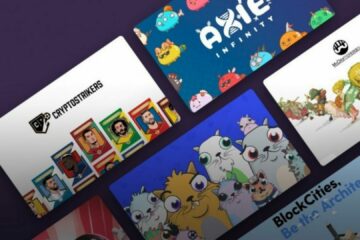NFT stands for a non-fungible token created using blockchain technology. As the name suggests, the non-fungible token is unique in its form and not replaceable with another duplicate unit. You can also think of the non-fungible token as a distinctive digital property that has no other copy in the world.
This makes an NFT different from its blockchain predecessor called a cryptocurrency, which holds the exact value along with other identical cryptocurrency tokens in a manner similar to real currency.
Sounds tricky? That’s because it’s a bit confusing at first. After all, if an NFT does not exist in physical form and cannot be replaced with an identical token, how are real world assets such as works of art sold as NFTs?
Although this is a very good question, it has a very simple answer
A NFT does not exist in physical form, but it can represent tangible assets in a digital capacity. Taking the above example of a work of art that would have been turned into an NFT, the physical asset itself is not molded into a tangible token in this case. Instead, it just has a unique digital representation in the form of a non-fungible token on the blockchain.
When a physical asset is offered or sold as an NFT, it means that the associated non-fungible token contains unique digital attributes that represent that asset on the blockchain. Since the NFTs for physical assets are rigorously brought into compliance by credible platforms, anyone holding the respective NFT can determine the ownership of the related asset.
As a result, the person who owns a physical asset and turned it into an NFT can sell it through the blockchain. The person who buys it next can be determined to be the owner of the NFT as well as its associated physical asset. This property is also true in situations where digital assets are involved; they are simply devoid of the physical property part.
Now comes the part on the irreplaceable quality of NFTs and their ability to be bought and sold despite this distinction.
How to buy an NFT?
You might still be wondering if NFT is such a unique token, how can someone buy it in the first place?
Again, the answer is not that complex.
Although NFTs are very distinctive and are not directly replaceable with an identical token, the owner of an NFT may decide to sell it for ordinary cryptocurrency. This is similar to purchasing a rare collectible in regular currency. While you cannot complete your transaction by giving the seller a copy of the exact item, you can pay the price they set to own the collector’s item.
Due to this mechanism, NFTs are sold left, right, and center through cryptocurrency transactions. If the price offered by the potential buyer matches the seller’s projection, the seller can accept it and receive the respective amount in cryptocurrency. The sale ends once the seller transfers the NFT to the buyer’s blockchain wallet.
If the NFT is the representation of a digital asset such as a tweet or meme, the new owner can claim it as a collector’s item. Now suppose the NFT represents a physical asset that exists in the real world, the new buyer can choose to use the asset in their physical environment as well.
Which Blockchain Platform Is Trading In NFT?
Contrary to the misconception of some people, NFTs have not gained their popularity through the Bitcoin blockchain. Although Bitcoin is the world’s first and most popular cryptocurrency, it doesn’t have the particularity of bringing NFTs to the mainstream market.
That paintings are sold for millions in the art world is nothing new. So far, however, physical objects have been acquired in the process. That is changing now. On platforms like OpenSea and SuperRare, digital works of art of all kinds are sold for money – some only cost a few cents, others millions of dollars. Prominent names are also taking part: Most recently, the pop singer Grimes auctioned several works for a total price of 6 million dollars.
What is special about all of this is that the works of art remain freely available on the Internet even after they have been sold, and even a seven-digit price does not mean that a physical object actually changes hands. The purchase takes place purely digitally – as an “NFT”.
What are NFTs?
NFT stands for “Non Fungible Token” – online goods that cannot be replaced or destroyed. To do this, they use a blockchain – the same technology on which crypto currencies such as Bitcoin are based. The special thing about blockchains: unlike usual on the Internet, data is not stored in a central location, but on numerous computers at the same time. This makes data on the blockchain particularly forgery-proof, but also very energy-consuming.
To sell a digital work of art as an NFT, ownership of the work of art is written on one of the numerous blockchains: Ethereum, for example, is popular for this. This means that the whole world can see who has bought the NFT: The ownership claim is stored in a traceable manner on the entire blockchain.
Why would you buy an NFT?
Just like in the classic art market, the prices for NFTs are not linked to real values in the real world. A work of art is worth what people are willing to pay for it. And now it is no longer even necessary to hang up the picture so that visitors can see it – after all, this is not possible with an animated cat. A purely digital title deed is enough for the digital art collector.
This means that theoretically everything can be traded digitally as a work of art: pictures and pieces of music, but also virtual items of clothing and even tweets.
What could the future look like for NFT?
Some artists see NFTs as a potential new source of income. Musicians like Deadmau5 and Lil Yachty have also already sold NFTs from their works. Fans use the opportunity here to support their favorites in an uncomplicated way. However: So far, the main focus here has been on big names. A largely unknown artist would find it very difficult to get a good price for her work in the flooded NFT market.
Elsewhere there is hope that the concept could also be used in areas other than the art market: for example to buy an upgrade in a video game or to receive a trophy.
Why are NFTs criticized?
After years of big announcements and little results, however, the usefulness of blockchain projects remains controversial – and NFTs are no exception. For example, it is criticized that copyright infringements can easily occur on digital marketplaces – the blockchain itself cannot know whether the seller actually has the rights to the object being sold.
In addition, ownership of the digital art is limited to the blockchain on which the purchase took place. The Nyan Cat buyer made the purchase on the Ethereum blockchain, and only there is the purchase noted. Since new blockchains are constantly emerging that support NFTs, Nyan Cat could theoretically be sold to other people on all of these blockchains.
The energy consumption of the blockchain also remains a controversial topic. Because they run on numerous computers at the same time, blockchain projects need a lot of electricity. According to a study, the best-known crypto currency Bitcoin alone consumes more energy than the entire country of Argentina. As long as a large part of the world’s electricity is generated from fossil fuels such as coal and gas, this also creates a considerable burden on the climate.
The markets have evolved into what they are today for good reason. It is much easier for customers to visit one place to find everything they need than for them to search in the city. Mom and Pop stores or boutiques can be a refreshing change of pace, but most people rely on the convenience of places like Walmart or Target. It is simply more efficient.
Centralized markets are not new. Crowded bazaars existed long before the Internet. Sellers have always done better to follow customers instead of expecting customers to follow them, even if that means paying a small fee for the privilege of showing their products to a larger audience gathered by the marketplace. .
Market coordinators need funds to pay for your accommodation and their time. Many markets provide ancillary services to help attract more customers, such as decorations, currency exchange, entertainment, etc. Unfortunately, the vastness of the Internet has caused the accumulation of an imbalance between the wealth and resources of these central markets. This imbalance gives them the power to charge unreasonable rates for their accommodation. They also have the freedom to choose which sellers are allowed to participate in their market, the flow of customer traffic, and how products are displayed.
DeFi (decentralized finance) technology enables the inherent convenience of centralized markets without allowing the wealth management and governance authority to pool in a person’s wallet. Essentially, DeFi is enabled by the blockchain, which allows peer-to-peer transactions without authorization. This removes intermediaries like banks and other large financial institutions. It reduces costs and technical barriers for entrepreneurs and individuals. Fees, documentation, and legal jurisdictions prevent many people around the world from accessing the financial tools they need to be successful. DeFi platforms bypass the need for all of these things and allow them to transact in a secure environment.
NFTs are the driving force behind an important part of DeFi infrastructure. NFTs aren’t limited to collectibles. They represent programmable data bits stored on the blockchain. Blockchain provides a transparent and hack-proof storage solution. This is equivalent to the ownership of data elements that can be programmed to do different things when they interact with them. Let’s break this down and demonstrate how new DeFi platforms decentralize e-commerce in a safe and efficient way. pay for it. There is no way to duplicate it or steal it. Even after its sale, it can be programmed to continue paying royalties to the original owner. It’s easy to see how these concepts quickly translate into e-commerce potential. NFTify provides entrepreneurs with a platform to build an online digital NFT store without the need to write a single line of code. It is also equipped with AI that helps detect NFTs that might be similar to yours, increasing the protection of the already secure blockchain network. This puts a small business in the hands of an individual without the need to establish their own infrastructure.
Another project takes this concept to the next level by allowing users to build an eCommerce store from real world items. Splyt uses NFTs to represent real world items instead of digital items. Now translate all that earlier potential into real retail. Inventory data is stored on the blockchain, preventing any market that lists the NFT from selling it twice. Entrepreneurs can sell NFTs and collect royalties whenever that item is resold. Affiliates can sell products with NFT at a profit and get paid immediately because of the way the NFT is programmed. It uses what is called a smart contract to hold and transfer the funds. Buyers will know their purchase is genuine because the NFT cannot be duplicated or tampered with. The problems of scalping and counterfeiting would be a thing of the past.



0 Comments